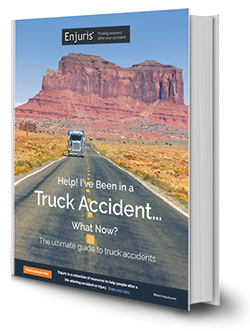A collision between a passenger car and a commercial truck can cause long-lasting or permanent injuries.
If you’re like most Americans, you’ve probably been in a scrape or two between passenger cars — hopefully, nothing more than a parking lot dent or fender-bender. Those kinds of collisions happen to everyone at one time or another.
But truck accidents can be much more serious, and they can result in long-lasting injuries, permanent disability, or death.
The National Highway Traffic Safety Administration reports on traffic safety facts. In 2017, 4,471 people were killed nationwide in accidents involving large trucks. Of those fatalities:
- 72% were occupants of other vehicles
- 18% were occupants of the large trucks
- 10% were not in a vehicle (pedestrians, bicyclists, etc.)
Looking specifically at New York truck accidents, here’s what the statistics show: In 2017, there were 1,366 vehicles involved in fatal crashes in New York. Of those, 115 (8.4%) were large trucks.
| New York truck accident-related fatalities in 2017 | |
|---|---|
| Truck occupant fatalities in single-vehicle truck crash | 10 |
| Truck occupant fatalities in multi-vehicle truck crash | 3 |
| Fatalities for person in other vehicle | 75 |
| Non-vehicle occupant truck crash fatalities | 33 |
| Total 2017 truck accident-related fatalities in New York | 121 |
|
Source: NHTSA Traffic Safety Facts, 2017 data |
|
One reason why truck accidents are more likely to result in fatalities than passenger car collisions is simple physics — they’re huge! The legal weight for an 18-wheeler is 80,000 pounds before an oversized load. In comparison, the average passenger vehicle weighs about 5,000 pounds.
Common causes of truck accidents
Collisions don’t necessarily fit into neat little categories. Anything can happen, and an accident can be the result of more than one cause. In many cases, a truck accident is caused by driver error — either yours or the truck driver’s.
Here’s how driver error can cause an accident:
- Driver fatigue. There are laws and regulations about how many hours a truck driver is allowed behind the wheel per shift, and how many hours of sleep are required in between shifts. Unfortunately, many trucking companies don’t follow the rules. Sometimes, the drivers can’t make good enough time to travel the number of miles required for a load, so they choose to cut corners on the amount of sleep they get. This results in drivers who fall asleep at the wheel, or who lose concentration or coordination and are slow to react to a traffic situation.
- Distracted driving. Distracted driving isn’t just an issue for truck drivers. It’s a huge problem for everyone — including teens and adult drivers — and it’s not just about texting and driving. Distraction can be anything from eating, to flipping radio channels, to simply getting lost in your thoughts and losing concentration on a long and boring strip of highway. Taking your eyes, hands, or mind off the task of driving, even for a split second, can result in disaster.
- Alcohol and drug use. Nearly a third of truck drivers admitted to using amphetamines on the job, according to a Reuters Health study. Another 20% admitted to using marijuana, and 3% used cocaine. Often, it’s appealing to a truck driver to use amphetamines or cocaine in order to stimulate themselves to stay awake while driving. The hazard is that these drugs also compel drivers to take unnecessary risks (like speeding). Also, the drugs’ effects wear off quickly, which makes it more likely for a driver to fall asleep at the wheel.
- Speeding. Drivers are under pressure to make tight deadlines. A driver might be at risk of losing their job if they can’t deliver a load on time, and that might mean they’re going to speed to get there. For an 18-wheeler traveling 55 miles per hour on dry pavement, it can take 390 feet (or 4 seconds) to come to a stop. That might not sound like much, but if you’re in a small car in front of a big truck and you need to come to a sudden stop, then you could be at risk if the driver can’t stop the truck fast enough.
Types of truck accidents
Driver error is a real hazard on New York roads, and although some accidents are just that — accidents — quick reaction time and proper training can prevent tragedies from happening.
Here are some of the ways that truck accidents happen:
Tire blowout accidents
Both cars and trucks can have tire blowouts. When that happens, it can cause the vehicle to swerve into another lane, roll over, or jackknife. A tire blowout is usually caused by wear and tear, defective manufacturing, or routine maintenance deficiencies.
If a truck tire blows out, the debris from the broken tire could hit other cars, or the truck could collide with other cars if it swerves out of its lane.
Jackknife truck accidents
A “jackknife” is when the cab and trailer portions of a big rig fold at the joint. If the back of the trailer moves faster than the cab, it creates a sharp angle that causes the truck to face 2 directions. If this happens, the driver no longer has control over the vehicle. A nearby car could collide with the swinging trailer or wedge underneath the rear of the truck.
Underride truck accidents
A passenger car can slide underneath a truck, either from the rear or the side. The height difference in the vehicles could mean that the top or front of the car could be crushed and its occupants seriously injured.
Hazmat truck accidents
“Hazmat” stands for hazardous materials. This classification could include anything from gasoline, to pesticides, to lithium batteries, to dry ice. What classifies cargo as hazardous is if it’s either highly flammable or could become harmful to breathe if it becomes airborne.
A hazmat accident can affect not just the drivers on the road, but also anyone in surrounding areas. If a toxic substance is released into the air or certain bodies of water, it can affect people in nearby communities.
Unsecured load accidents
There are many federal regulations for loading cargo, and the main consideration is that the haul must be immobile and secure. The truck’s restraint system must be strong enough to keep cargo from sliding or shifting.
There are 2 ways an unsecured load accident could happen:
- If the truck is involved in an accident and the load isn’t secured properly, it can create additional hazard because the impact could cause the cargo to slide into oncoming traffic, or onto the road.
- The other possibility is that the instability of the load, itself, can cause an accident if the truck’s center of gravity is thrown off or the movement causes the truck to move unpredictably.
Continue reading about the different types of truck accidents and how to avoid them.
- Don’t drive distracted. We mentioned this earlier — but it’s so important that it’s worth talking about again. If you’re the driver, you need to have your eyes on the road, hands on the wheel, and mind on the task of driving at all times. Turn off notifications on your phone before you get in the car so you’re not tempted to sneak a quick peek while you’re driving. Queue up your music, podcasts, or whatever you listen to ahead of time so you have no reason to look at your phone while driving. In addition, keep your car environment free from any distraction, whether from your passengers, personal grooming, eating or drinking, or any other task that diverts your attention away from driving.
- Leave plenty of space between your vehicle and the truck. The most effective form of prevention is to leave enough room to make sudden stops or other maneuvers, and to avoid traveling alongside a truck or in the driver’s blind spot. The general rule of thumb is if you can’t see their mirrors, they can’t see you. Certainly, you need to pass a truck from time to time. But try to wait until you’re sure there’s enough room to pass quickly without having to linger in the lane directly adjacent to the truck.
Who’s at fault for a truck accident?
The basis for personal injury law is establishing liability, or fault.
When you’re involved in a car accident, there’s a likelihood that fault can be assigned to one or both drivers (or more, if there were more cars involved). But it’s not always that simple for truck accidents.
The liability in a truck accident is often more difficult to establish because there are more possibilities for who could be at fault.
For starters, there are 3 types of truck drivers:
- Owner-operators, who own the trucks they drive and either function as independent contractors (contracting with shippers for delivery services) or they lease vehicles to a trucking company.
- Company drivers, who are employees of a trucking company and drive that company’s trucks.
- Independent owner-operators, who drive their own trucks to haul goods from their own company.
Determining which type of truck driver is responsible for your crash matters because establishing liability will likely depend on which type of truck driver is involved. If you’ve been in a truck accident, you probably need a lawyer who can sort out important details such as how the driver is employed and who’s responsible for the truck’s maintenance.
Vehicle maintenance could also be an important factor for liability. The person or company that owns or leases any vehicle is responsible for its maintenance. If there’s a contract between the owner and shipper, there probably are provisions in the contract that address maintenance. Even the truck driver might not know who’s responsible for maintenance under the contract, so your personal injury lawyer will likely have to request that information during the discovery process.
A big rig likely contains parts that come from a variety of manufacturers. The engine components could be from one manufacturer, while the cargo restraint apparatus is from another company. That’s why determining fault is a job for your lawyer... it’s not always easy to figure out.
If the accident was caused by an equipment defect, it might become a product liability lawsuit.
If the accident was caused by faulty brakes or other mechanical malfunction, liability could be on the manufacturer or the manufacturer of that specific part. If the accident was the result of improper loading or other cargo issue, or some failure that should’ve been detected during routine maintenance, that would be the fault of whoever had the responsibility to maintain and load the truck — the shipper, driver, owner, etc.
Even if the accident was driver error, it could still be the company’s liability (or the company and the driver could both be defendants). In certain circumstances, an employer is responsible for the negligent acts of an employee. Truck accidents sometimes happen because the driver was on the road for too long, went too many hours without sleep, or didn’t take enough rest stops. The employer can bear some responsibility for those situations.
New York comparative negligence law
What if the accident was caused by the truck operator, but you also made a mistake?
It happens. A traffic stop ahead might require you to make a split-second reaction, and you might make the wrong decision at that moment.
There are 4 primary ways that states assess liability and fault. Some don’t allow a plaintiff to recover any damages if they had any responsibility for the accident.
In New York, a plaintiff can recover damages, even if the accident was partially their fault.
For example, let’s say you’re passing a big rig in the left lane. You see that it begins to swerve (it turns out that it was moving left in order to avoid an obstruction on the right shoulder). You could swerve onto the left shoulder to avoid collision, but you react a moment too slowly and the truck sideswipes you. Although it’s not your fault, the court could find that you bear a small percentage of liability for not moving to the left shoulder fast enough to avoid the crash.
This system is called comparative negligence. If you were awarded damages for the truck accident, the court would reduce the amount of damages you receive according to the amount of liability you have for the accident.
Look at it like this:
In the above scenario, the court awards you $100,000 for the damages to your car and your personal injuries. It finds that you were 10% responsible for the accident. Therefore, your damage award is reduced by 10% (which is $10,000). You would receive $90,000.
New York truck accident damages
You can recover damages in a New York personal injury claim for costs associated with your physical or emotional injuries, property damage, and other financial losses.
Truck accidents can often result in serious and disabling injuries, which means you might require coverage for not just medical costs you’ve already incurred, but also future medical expenses and costs of living if you’re no longer able to earn the salary you had before the accident.
Damages after a truck accident include:
- Medical expenses, including doctor and hospital visits, surgeries, outpatient procedures, prescription medications, etc.
- Costs for adaptive devices
- Ongoing treatment like physical or occupational therapy
- Lost wages (past and future)
- Costs for property damage (like repair or replacement of your vehicle)
- Compensation for assistance with daily activities (like child care, personal aide, etc.)
- Pain and suffering, for PTSD and other emotional distress caused by the crash
- Funeral and burial expenses, if the crash resulted in the death of your loved one
If you’ve already made a full recovery and are certain you won’t require additional treatment, you might be able to calculate your total expenses.

Damages worksheet to track expenses for your injury claim (medical treatment, property damage, lost wages, prescriptions)
Download in PDF format
If you require additional treatment or are continuing to lose time from work because of your injury, it’s probably wise to consult a personal injury lawyer. Handling disability or social security claims, calculating future loss of earnings, and assessing future medical treatment costs can be tricky. Your lawyer will work with accountants, actuaries, and medical experts to make sure that the damage calculations are accurate so that you get what you deserve. The last thing you want is to be short-changed because of miscalculated damages.
Enjuris offers a variety of resources designed to help you navigate the aftermath of a truck accident. Feel free to use the Enjuris Personal Injury Lawyer Directory to find a New York truck accident lawyer near you who can evaluate your claim.
Did you know that truck accident law varies by state?
Need a lawyer?
What does an injury lawyer do?
A personal injury lawyer helps individuals who have sustained injuries in accidents to recover financial compensation. These funds are often needed to pay for medical treatment, make up for lost wages and provide compensation for injuries suffered. Sometimes a case that seems simple at first may become more complicated. In these cases, consider hiring an experienced personal injury lawyer. Read more














